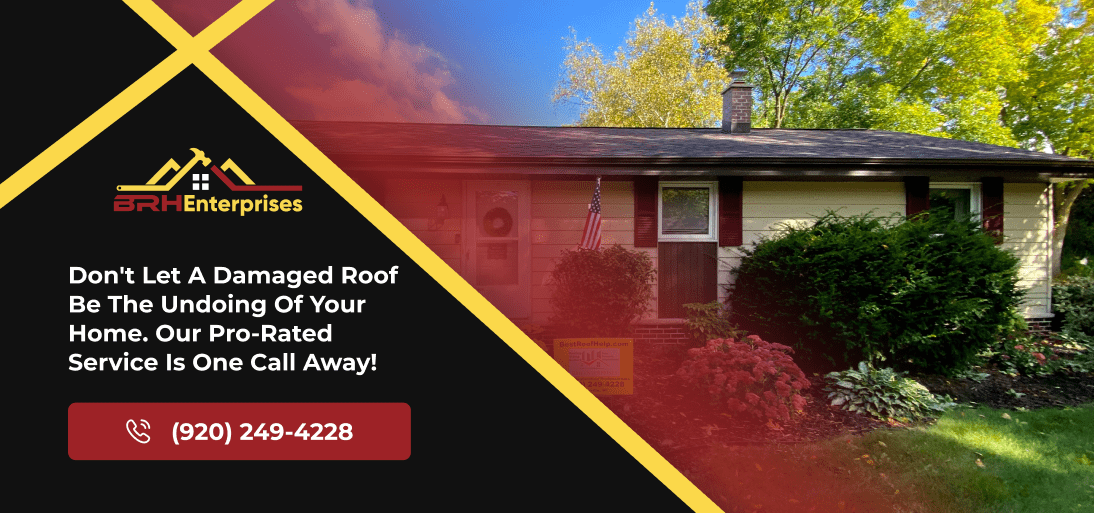What Causes Roof Shingle Discoloration and How to Fix It
Estimated Reading Time : 4 Min.

For the general health of your home, it is essential that you maintain the integrity of your roof, and this includes dealing with roof shingle discoloration. This blog post will discuss the different reasons for roof shingle discoloration and offer easy fixes to bring back your roof’s aesthetic appeal.
What Are The Causes of Roof Shingle Discoloration?
There are many different things that can cause your shingles to fade or stain, including the following:
#1. Algae Growth
Algae is one of the most common causes of roof shingle discoloration, and if not addressed it can cause significant damage to the roof structure. The materials in the shingles, specifically powdered limestone, make it easier for algae to grow as they feed on the filler, spreading over the roof and causing discoloration. Different types of algae, such as blue-green algae, black algae, and red algae, are naturally pigmented and make the roof change color. Algae can prevent water from properly draining off the roof, causing leaks, materials deterioration, and mold growth.
#2. Rust Stains
Rust can damage the roof’s structure and is as shown by marks that are red or brown in color. Roof flashing, chimneys, and other metal elements that are worn down or damaged can be the source of this. Damaged and rusty roof components like flashing may let water seep into the roof, so it’s important to repair them promptly. To find and fix rust or damage, routine inspections are essential, especially around chimneys.
Likewise, fasteners or nails can leave similar stains and can be carefully treated by sanding the rust away and painting or sealing the area. Surface wear can release these particles that leave marks on different parts of the roof. Rust mark removal techniques include specialized cleaners and rust inhibitors.
#3. Lichen and Moss Growth

The growth of lichen and moss on roofs is another cause of discoloration and retention of moisture. Generally speaking, the three things that thrive on roofs—moss, algae, and lichen—do best in moist, cool environments. Shingles may deteriorate earlier than anticipated if lichen and moss attach themselves and remove the granules. Rhizoids, which resemble roots, allow moss to attach itself to the roof.
Bird droppings are a common source of moss and lichen growth on roofs because they provide nutrients that promote the growth of these materials. Installing copper or zinc-coated sheet metal strips along each side of the roof, cutting overhanging tree branches, using algae-resistant shingles, cleaning the roof with a chemical cleaner, and scheduling biannual roof inspections are all essential steps in preventing and treating lichen and moss growth on roofs.
Also Read: Your 3-Step Roof Moss Removal Guide In 2023
#4. Asphalt Bleed Through

As the oils in asphalt shingles rise to the surface, they create a dark, sticky substance that causes black streaks to appear on the roof. This type of phenomenon is commonly referred to as asphalt bleed through. High temperatures, poor quality asphalt shingles, and insufficient ventilation are some factors that contribute to this problem.
It’s crucial to speak with a roofing expert to determine whether replacement is necessary before you attempt to clean asphalt bleed through. These stains can be removed with oxalic acid, but it is crucial to take safety precautions. Keep in mind that asphalt bleed through can mimic the appearance of algae stains on a roof, with both appearing as dark patches.
Also Read: A Quick Look At Asphalt Roof Color Trends for 2023
How to Fix Discolored Roof Shingles
How you clean your asphalt shingles will depend on the cause of the discoloration. Consider using the methods below, and if you aren’t sure which option is best, consult with a roofing contractor for advice.
1. Use a diluted solution of chlorine bleach and water to lighten algae discoloration
To address algae growth on roofs, a solution of 50% water and bleach can be applied to the roof surface. Avoid the use of pressure washers to prevent shingle damage. Additionally, inserting zinc or copper strips under the top row of shingles near the roof peak can help prevent the return of algae. For proactive prevention, consider installing synthetic roofing shingles, trimming trees to reduce shade, and removing debris that can cause standing water.
It is crucial to wear safety goggles and rinse any plants where runoff may occur both before and after using strong chemicals like bleach.
2. Remove rust stains
Oxalic acid is effective for treating rust stains on surfaces, including roofs, but precautions must be taken to ensure the safety of you and your roof. Here are key safety tips when using oxalic acid:
> Protective Gear: Wear gloves, goggles, and a respirator to prevent skin, eye, and lung contact.
> Avoid Ingestion and Inhalation: Do not ingest or inhale oxalic acid to prevent severe respiratory and digestive tract irritation, kidney damage, and health issues.
> Ventilation: Use oxalic acid in well-ventilated areas to minimize direct contact.
> Proper Disposal: Dispose of oxalic acid according to local regulations to prevent environmental damage.
Note that oxalic acid can be corrosive and may damage surfaces if not used properly. Always follow the manufacturer’s instructions and test the product on a small area before applying it broadly.
What Are Algae-Resistant Shingles?
Algae-resistant shingles are specifically made to stop algae from growing on roofs. Copper granules are used in these shingles to prevent mold, mildew, and algae growth, providing homeowners with a long-lasting and low-maintenance option.
The main advantages of these shingles are preventing unsightly stains, cutting down on energy expenses by avoiding algae-induced cooling, extending the life of the roof, and minimizing cleaning and maintenance expenses. In warm, humid climates, algae-resistant shingles are especially advantageous. For best results, it is advised to have regular professional inspections and maintenance performed.
Conclusion
Roof shingle discoloration is a widespread problem with multiple causes. By understanding these factors and implementing appropriate solutions, you can preserve your vibrant and robust roof.
Consistent inspections, prompt repairs, and the use of suitable cleaning techniques contribute to an extended roof lifespan and a visually appealing home. It’s essential to be cautious and seek professional assistance from BRH Enterprises if you aren’t sure how to tackle your roof shingle discoloration. Your roof is vital for safeguarding your home, so prioritize its maintenance for a long-lasting performance!


